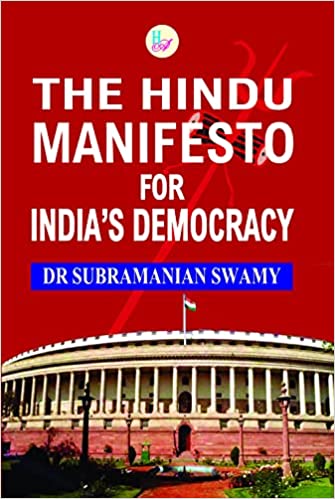The Hindu Manifesto, written by Dr Subramanian Swami, is an analysis to bring primarily young Hindus together and to create a sense of belonging to India’s great civilisation and a vested interest in India’s future potential. The current young generation of Indians have all the technical advantages of a modern generation but are still burdened with an education system that does not accurately reflect past glories and failures, as history taught in schools is still the history written by foreigners. 5,000 years of Indic ingenuity and civilisation are overlooked, as are India’s epics.
Dr Swami pens an authoritative chronology of why India needs unity and how to achieve it. Swami is well known for his Hindutva ideology and herein it is explained in depth traversing geographical, philosophical, scientific, intellectual, moral, and social responsibilities. The Sanatan Dharma aspect is responsible for why Hindus have maintained such a strong sense of identity and the stoic aspect explains why Hindus have tolerated centuries of colonialism.
The author debunks the notion of caste-by-birth and the Aryan-Dravidian racial divide in favour of caste by merit; he contends all Indians are originally from Hindustan ergo originally Hindus, and therefore all the Indians of today sharing the same DNA, except perhaps the Parsis and Jews who sought refuge and were welcomed in India’s society.
Essentially the author is inviting Hindus to rediscover and unite to preserve their culture, but his definition of Hindu beliefs is so liberal it is absolutely clear Hinduism/Sanatan Dharma is available for non-Indians from anywhere to follow.
But to realise this Hindu renaissance there are challenges, Indians have been denied the National advancement they deserve, Swami convincingly lists the conspirators against India’s development, and how their techniques have subliminally succeeded in eroding confidence and creating a sense of victimhood and lack of empowerment, and how time and time again Hindus have to greater and lesser degrees capitulated to some sort of degradation. Defaming India has taken many guises over the last 500 years, arresting India’s ingenuity and emerging power has become obsessional for some.
There is a chapter on Dr Swami’s vision of ‘Enlightened Secularism’, wherein the state and religion are separate and the state is neutral to all religions, the state exists to facilitate adaption and integration, but not to enact laws or policy to please any religious orthodoxy. This chapter presents the various interpretations of secularism found in India today and attempts to evoke, to some extent through Mahatma Gandhi’s argument for truth, a one size fits all secularism peculiar to an emerging superpower, whose religious majority is determined to carry its faith intact into the next millennium. Dr Swami argues this is achievable through the introduction of the Uniform Civil Code.
India has had many missed opportunities to self-correct since 1947, the first was an atheist/leftist Prime Minister immediately after the sub-continent was divided on the basis of faith. India’s heroes from Savarkar, Bose, Ambedkar, Patel, PVN Rao, were all heroes of the people and the nation but circumstances shrank their ideals and efforts. Since 1947 India’s brave attempts at a market economy have been short lived and not fluent enough for fast economic development. In this segment Swami, the economist comes in his own, recommending social reforms to project into and at the same time protect India’s vulnerable from globalisation. The author describes it as Integral Humanism (derived from Deendayal Upadhyaya’s concept), you could say it is moral capitalism effectively and fully integrated with social responsibility, this is exactly a continuum of ancient Hindu tradition that got interrupted by imperialism, leftism and the anti-India conspiracies outlined in the earlier chapter. His three starting points are GDP must grow by 10% per annum, instilling a secular patriotic ethos and work ethic across communities, and the right international strategic alliances. Swami racontes some of his economic experiences and concludes that Upadhyaya’s recipe for “Swadeshi and Decentraliation” are still relevant today.
On the subject of national security Swami revisits India’s greatness and predicts India’s economy could be 3rd largest in the world by 2030, behind China and US, but only with the correct policies decided by modern-minded leaders. Swami prescribes the necessity for a indigenous nuclear weapons delivery system, modernisation and development of the Indian Navy, and a mindset prepared to protect India’s people at home or in a diaspora, India’s borders, culture, influence, and to counter extremism, terrorism and human rights abuses. The author dives in-depth into the complex history of Kashmir as an exemplar of why a national security doctrine that seeks to position India as a global power pole in a multipolar world is essential.
Throughout there are repeated references to the fundamental importance of Sanskrit, of the lofty ideal of a Chakravartin to unite and steer India and the world towards harmony and peace; even a suggestion of an Acharya Sabha, a third parliamentary house full of impartial neutral wisdom drawn from the Rishi, Yogi, Seer traditions, that could enlighten and advise the upper and lower houses in times of disunity and confusion.
All of India’s aggressors have recognised something intrinsically special about Hindustan, why else would they want to conquer it, why else are they so threatened by the special quality that they want to stop India capitalising on it? That special quality is Hinduism, without it as Swami spells out India is destroyed forever.
The Hindu Manifesto: declaration for nation building
- Advertisement -

